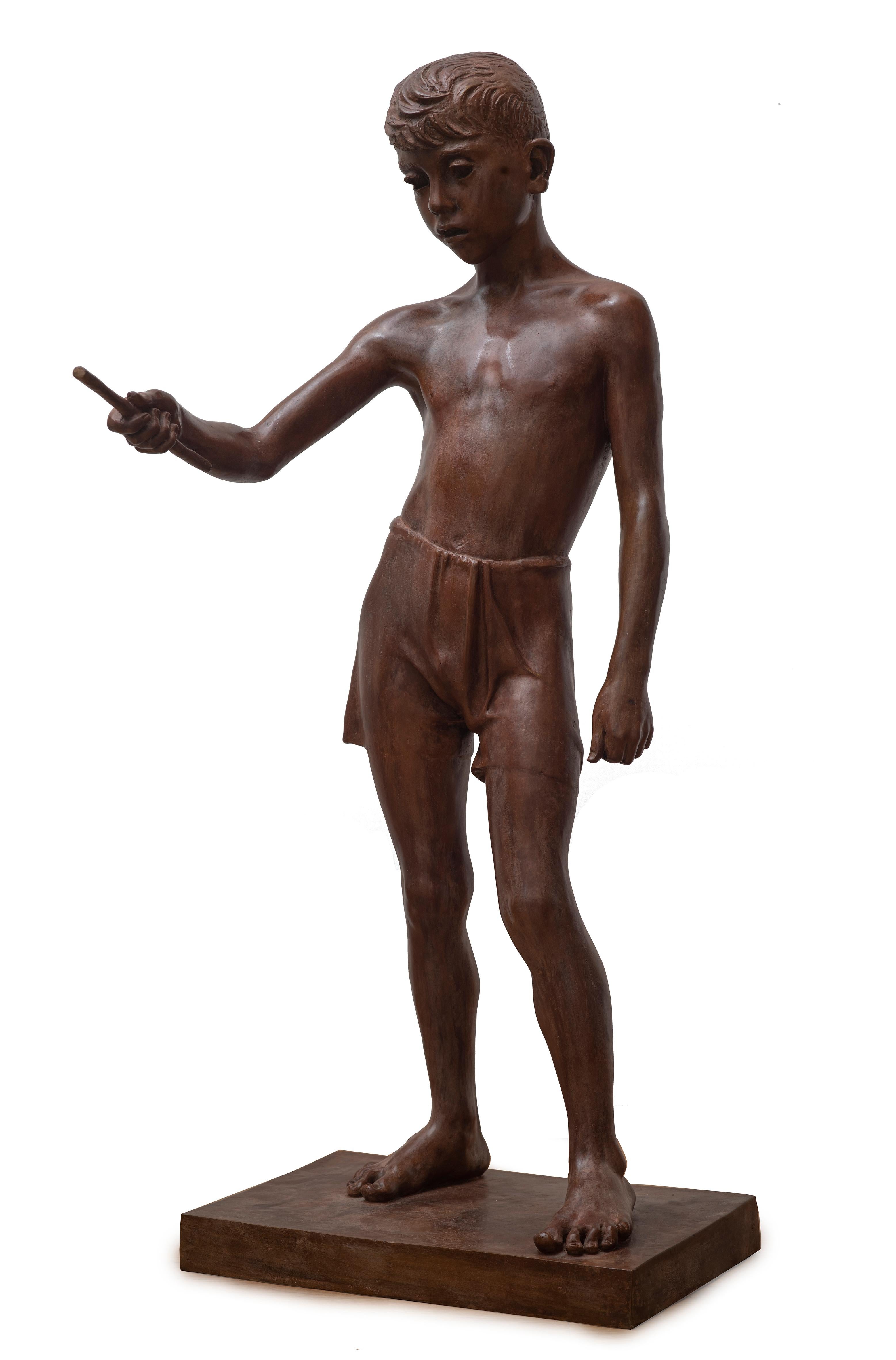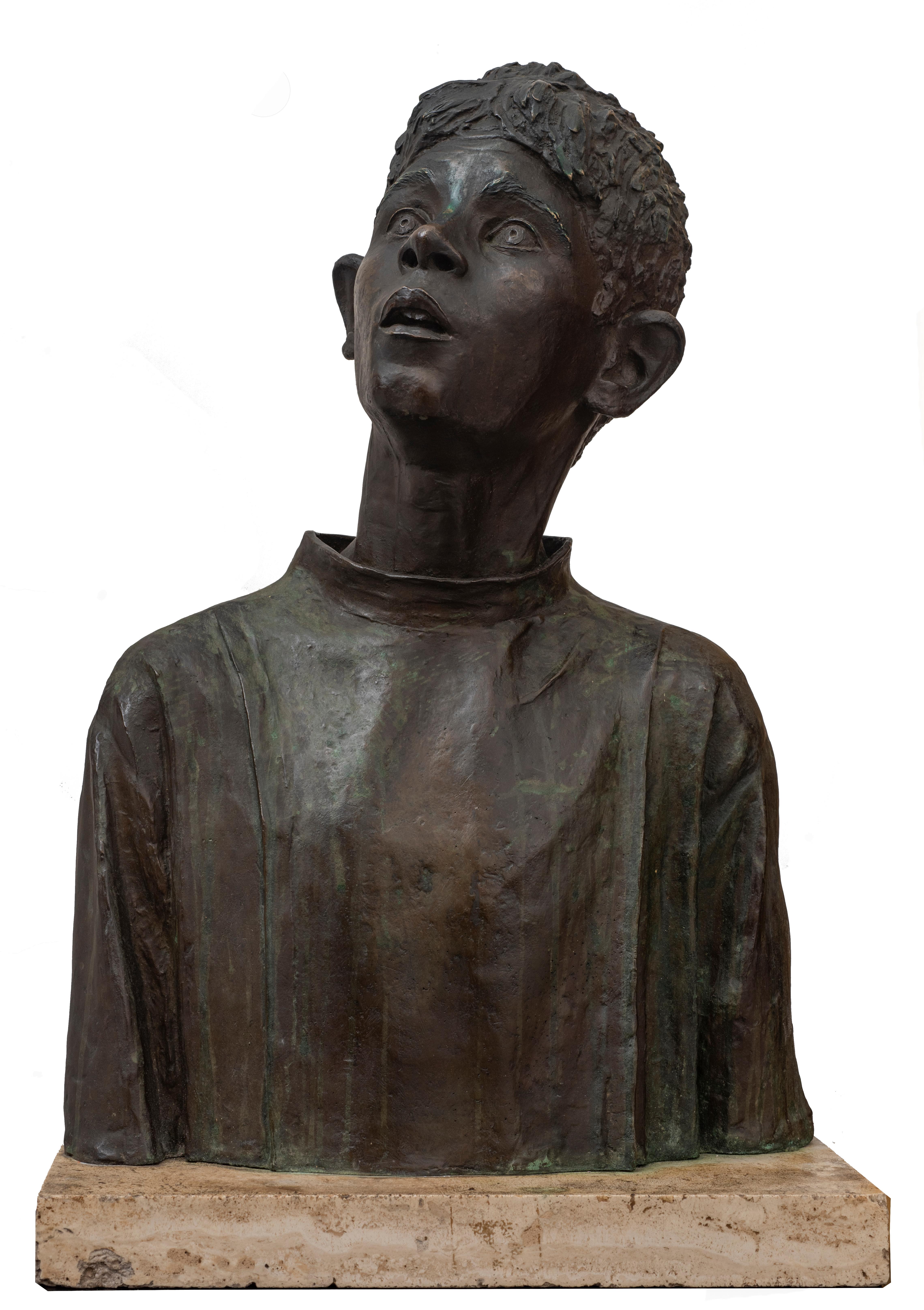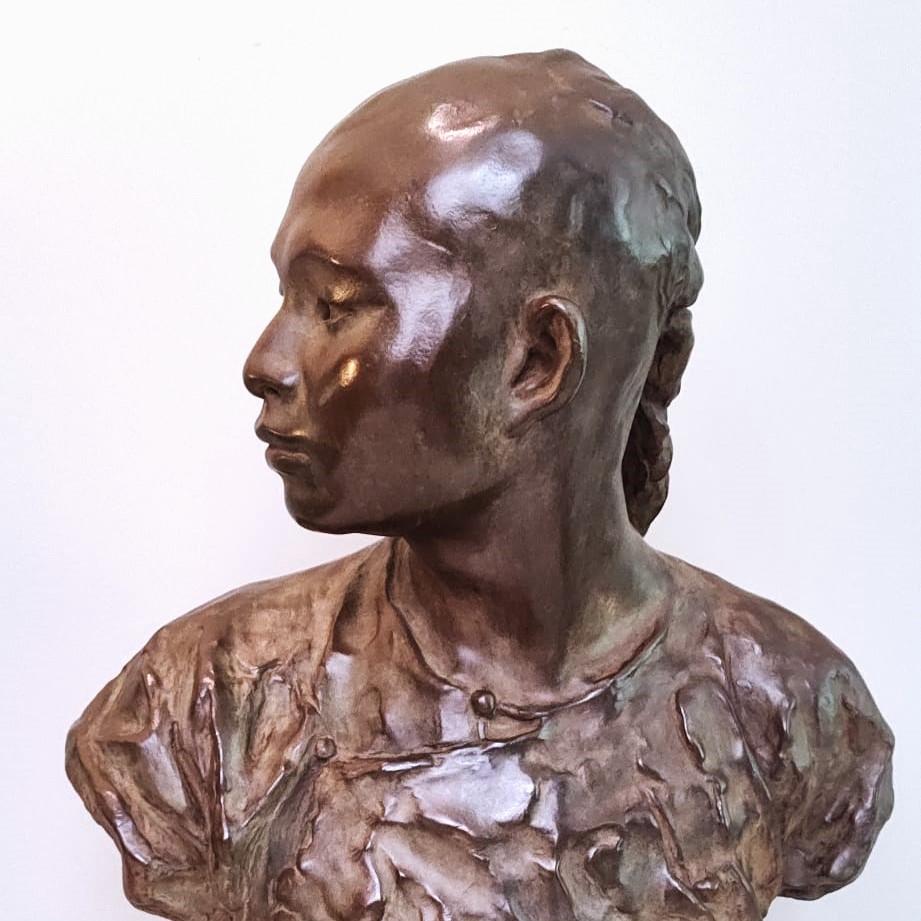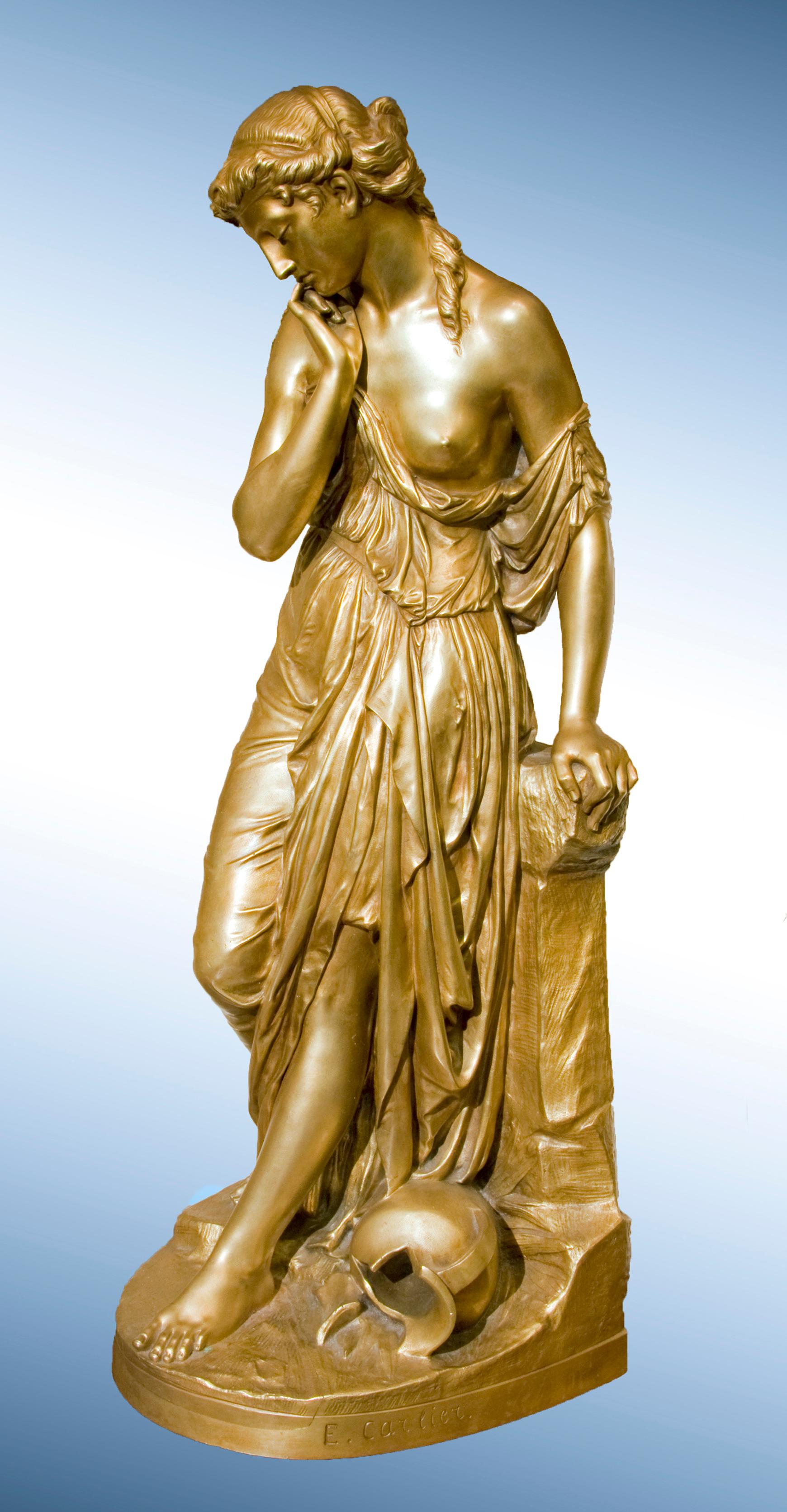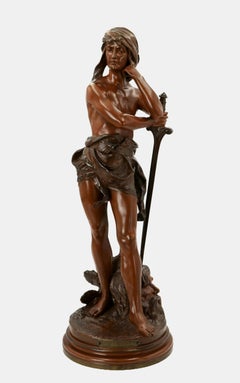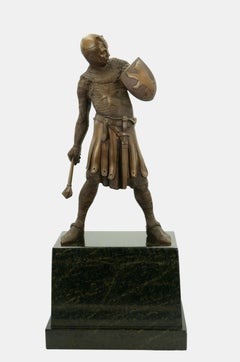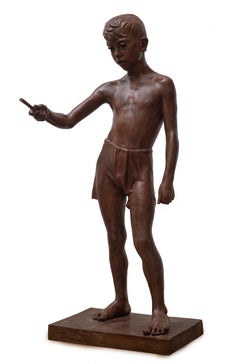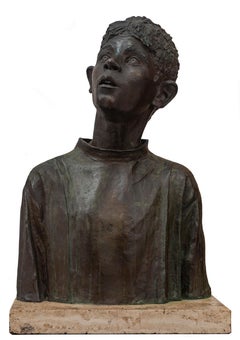Items Similar to Field worker with rake / - The Humility of the Farm Worker -
Want more images or videos?
Request additional images or videos from the seller
1 of 10
Paul Ludwig KowalczewskiField worker with rake / - The Humility of the Farm Worker -c. 1900
c. 1900
About the Item
Paul Ludwig Kowalczewski (1865 Mieltschin - 1910 Berlin), Field worker with rake, around 1900. Brown and brown-greenish patinated bronze with cast naturalistic plinth mounted on a white veined marble base (10 cm high), total height 50 cm. Dimensions of the bronze: 40 cm (height), x 16 cm (width) x 13 cm (depth), weight 10.8 kg. Signed “P.[aul] L.[udwig] Kowalczewski.” on the plinth and also with the abbreviation “fc. [fecit]” as the work of the artist.
- Slightly rubbed and minimally stained in places, overall in excellent condition for its age
- The Humility of the Farm Worker -
Paul Ludwig Kowalczewski, who himself grew up in a rural region of Poznan, elevated the field worker to an independent pictorial subject. However, not as a new hero of the time, as the metalworker in particular was portrayed as an agent of progress, but as a humble older man. Having finished his work, as indicated by the pedestal, the barefoot worker has taken off his hat to say a prayer bareheaded. He leans on his tool, a simple rake. Just as the Bible says after the expulsion from paradise, he has worked by the sweat of his brow throughout the advanced years of his life. A burden you can see on his hunched back.
He may have prayed the Lord's Prayer with his eyes half closed, reaching the line "Give us this day our daily bread". A thanksgiving for the daily bread, which the field worker helps to produce, and at the same time a plea for the nourishment of the soul, for man does not live by bread alone.
About the artist
Paul Ludwig Kowalczewski studied sculpture at the Berlin Academy of Arts from 1895 to 1898. From 1899 to 1906, the artist, who died at the age of 45, exhibited salon bronzes and life-size busts at the Great Berlin Art Exhibition. Kowalczewski was one of the first artists to depict workers and peasants in bronze.
GERMAN VERSION
Paul Ludwig Kowalczewski (1865 Mieltschin - 1910 Berlin), Feldarbeiter mit Rechen, um 1900. Braun und braun-grünlich patinierte Bronze mit gegossener naturalistischer Plinthe auf weißgeädertem Marmorsockel (10 cm Höhe) montiert, Gesamthöhe 50 cm. Maße der Bronze: 40 cm (Höhe), x 16 cm (Breite) x 13 cm (Tiefe), Gewicht 10,8 kg. Auf der Plinthe mit „P.[aul] L.[udwig] Kowalczewski.“ signiert und zudem mit dem Kürzel „fc. [fecit]“ als Werk des Künstlers ausgewiesen.
- vereinzelt leicht berieben und minimal fleckig, insgesamt in einem altersgemäß ausgezeichneten Zustand
- Die Demut des Landarbeiters -
Paul Ludwig Kowalczewski, selbst in einer ländlichen Region in Posen herangewachsen, erhebt den Feldarbeiter zum eigenständigen Bildsujet. Allerdings nicht als neuer Heros der Zeit, wie insbesondere der den Fortschritt voranbringende Metallarbeiter dargestellt wurde, sondern als demütigen älteren Mann. Nach getaner Arbeit, die von der Terrainplinthe angedeuteten wird, hat der barfüßige Feldarbeiter seinen Hut gezogen, um barhäuptig ein Gebet zu sprechen. Dabei stützt er sich auf sein Arbeitsgerät – einen einfachen Rechen. Ganz so, wie es in der Bibel nach der Vertreibung aus dem Paradies heißt hat er über die inzwischen fortgeschritten Lebensjahre hinweg im Schweiße seines Angesichts gearbeitet. Eine Last, die seinem gekrümmten Rücken abzulesen ist.
Er mag mit halb geschlossenen Augen in sich gesammelt das Vaterunser sprechen und bei der Zeile „Unser tägliches Brot gib uns heute“ angelangt sein. Ein Dank für das tägliche Brot, an dessen Herstellung der Feldarbeiter mitwirkt, und zugleich die Bitte um eine Speisung der Seele, da der Mensch nicht vom Brot allein lebt.
zum Künstler
Paul Ludwig Kowalczewski studierte von 1895 bis 1898 an der Berliner Akademie der Künste Bildhauerei. Ab 1899 bis 1906 stellte der bereits mit 45 Jahren verstorbene Künstler auf der Großen Berliner Kunstausstellung Salonbronzen und bis zu lebensgroße Büsten aus. Kowalczewski gehörte zu den ersten Künstlern, die Arbeiter und Bauern in der Bronzeplastik darstellen.

About the Seller
5.0
Gold Seller
Premium sellers maintaining a 4.3+ rating and 24-hour response times
Established in 2014
1stDibs seller since 2023
18 sales on 1stDibs
Typical response time: 6 hours
- ShippingRetrieving quote...Shipping from: Berlin, Germany
- Return Policy
Authenticity Guarantee
In the unlikely event there’s an issue with an item’s authenticity, contact us within 1 year for a full refund. DetailsMoney-Back Guarantee
If your item is not as described, is damaged in transit, or does not arrive, contact us within 7 days for a full refund. Details24-Hour Cancellation
You have a 24-hour grace period in which to reconsider your purchase, with no questions asked.Vetted Professional Sellers
Our world-class sellers must adhere to strict standards for service and quality, maintaining the integrity of our listings.Price-Match Guarantee
If you find that a seller listed the same item for a lower price elsewhere, we’ll match it.Trusted Global Delivery
Our best-in-class carrier network provides specialized shipping options worldwide, including custom delivery.More From This Seller
View AllThe Victorious David / - The melancholy of the radiant hero -
Located in Berlin, DE
Henri Honoré Plé (1853 Paris - 1922 Paris), The Victorious David, around 1890. Red-brown and brown patinated bronze with terrain plinth mounted on a round base. 62 cm (total height) ...
Category
1890s Realist Figurative Sculptures
Materials
Bronze
$3,895 Sale Price
20% Off
Reading Woman / - The golden glow of imagination -
By Albert-Ernest Carrier-Belleuse
Located in Berlin, DE
Albert-Ernest Carrier-Belleuse (1824 Anizy-le-Château - 1887 Sèvres), Reading Woman, around 1880. Polished bronze mounted on a cast base. 33 cm (total height) x 9 cm (length) x 9 cm ...
Category
1880s Realist Figurative Sculptures
Materials
Bronze
$2,226 Sale Price
20% Off
Crusader with shield and mace / - Ready to strike -
Located in Berlin, DE
Josef Moest (1873 Cologne - 1914 Rath), Crusader with shield and mace, around 1910. Bronze on a black marble pedestal (19 cm high). 57.5 cm (total height) x 21 cm (width) x 12 cm (de...
Category
1910s Realist Figurative Sculptures
Materials
Bronze
The Victorious David / - The melancholy of the radiant hero -
Located in Berlin, DE
Henri Honoré Plé (1853 Paris - 1922 Paris), The Victorious David, around1890. Red-brown and brown patinated bronze with terrain plinth mounted on a round base. 42 cm (total height) x...
Category
1890s Realist Figurative Sculptures
Materials
Bronze
$1,762 Sale Price
20% Off
Psyche / - Fulfilled longing -
Located in Berlin, DE
Jan Jozef Jaquet (1822 Antwerp - 1898 Brussels), Psyche, 1847. Black-brown and brown patinated bronze on a cast base. 30 cm (height) x 22 cm (width) x 12 cm (depth), weight 5 kg. Ver...
Category
1840s Realist Figurative Sculptures
Materials
Bronze
$1,391 Sale Price
20% Off
Joan of Arc / - The Liberating Power of Faith -
Located in Berlin, DE
Eugène Laurent (1832 Gray - 1898 Paris), Joan of Arc, around 1880. Brown patinated bronze on a cast rectangular plinth with tree trunk and distaff. 40 cm (height) x 15.5 cm (length) x 15.5 cm (depth), weight 6.1 kg. Signed “E.[ugène] Laurent.” on the plinth and inscribed “HZ” on the reverse.
- somewhat stained due to patina, traces of oxidation behind the distaff, slightly rubbed in places, overall still in very good condition for its age
- The Liberating Power of Faith -
At the age of 13, Jeanne, a peasant girl born in Lorraine around 1412, heard the voices of Saints Catherine and Margaret and the Archangel Michael telling her that she had been chosen to liberate France from English occupation. By 1428, Henry VI's troops had advanced to the Loire and besieged Orléans, a strategic city for the further conquest of France. Joan of Arc went to the exile of Charles VII and, with the king's consent, led the French army into battle against the besiegers. After four days of fighting, the English were defeated and Orléans was liberated. Other victorious battles followed, until in 1430 she fell into the hands of the enemy, who had her executed as a witch by the Inquisition. In May 1431, Joan of Arc was burned at Rouen.
After the final expulsion of the English, the "Maid of Orleans" was rehabilitated by the Church in 1456. She was finally canonized in 1920. By then, Joan of Arc had become a national heroine and the patron saint of France. After the French Revolution, the strengthening of the nation-state and the Franco-Prussian War of 1870-71, Joan of Arc was again venerated and depicted in numerous bronze statues.
Eugène Laurent depicts the young girl listening to the voices of the saints who reveal her destiny. With her eyes wide open, she gazes at the sky as if she were looking at the revealed future. Her hands are clasped in prayer, indicating her willingness to face her destiny. Leaning against a tree trunk, she treads with one foot on a raised stone, which, together with her upward gaze, gives her an upward movement that announces her higher mission. At the same time, however, she steps down from the stone to the earth, emphasizing her earthly mission, for which she has already taken the first step. In doing so, she steps over the discarded distaff, which refers to her "lower" origins and belongs to the life she has now left behind.
Laurent manages to capture the fateful emotion that makes us look at Joan of Arc in awe, even though she is a simple peasant girl. Even if the design is aimed at the overall impression, the artist has nevertheless worked out certain details, such as the tied waistcoat, very realistically and, in addition to the skin, has particularly depicted the material quality of the textiles.
About the artist
Eugène Laurent studied at the École des Beaux-Arts in Paris, where he won a prize in 1860. He then joined the studio of Jacques Antoine Theodore Coinchon. As a freelance artist, he supplied the Paris Salon with statues, portrait busts, and medallions from 1861 to 1893. He also created large sculptures such as the monument to Jacques Callot in Nancy (1877) and the statue of François Boucher at the Paris City Hall.
GERMAN VERSION
Eugène Laurent (1832 Gray - 1898 Paris), Jeanne d’Arc, um 1880. Braun patinierte Bronze auf mitgegossener rechteckiger Plinthe mit Baumstamm und Spinnrocken. 40 cm (Höhe) x 15,5 cm (Länge) x 15,5, cm (Tiefe), Gewicht 6,1 kg. Auf der Plinthe mit „E.[ugène] Laurent.“ signiert und rückseitig mit „HZ“ bezeichnet.
- patinabedingt etwas fleckig, Oxidationsspuren hinter dem Spinnrocken, stellenweise leicht berieben, insgesamt in einem altersgemäß noch sehr guten Zustand
- Die befreiende Kraft des Glaubens -
Als 13jähige vernahm das um 1412 in Lothringen geborene Bauernmädchen Jeanne Stimmen der Heiligen Katharina und Margarete und des Erzengels Michael, die ihr verkündeten, auserwählt zu sein, Frankreich von der englischen Besatzung zu befreien. 1428 waren die Truppen von Heinrich VI. bis zur Loire vorgerückt und belagerten die für eine Weitereroberung Frankreichs strategisch wichtige Stadt Orléans. Jeanne d’Arc begab sich ins Exil Karls VII. und führte mit der Einwilligung des Königs das französische Heer gegen die Belagerer ins Feld. Nach viertätiger Schlacht unterlagen die Engländer und Orléans war befreit. Es folgten weitere siegreiche Kämpfen bis sie 1430 in die Hände des Feindes fiel, der bei der Inquisition ihre Hinrichtung als Hexe erwirkte. Im Mai 1431 wurde Jeanne d’Arc in Rouen verbrannt.
Im Anschluss an die endgültige Vertreibung der Engländer wurde die „Jungfrau von Orléans“ 1456 von der Kirche rehabilitiert. 1920 erfolgte schließlich ihre Heiligsprechung. Inzwischen galt Jeanne d’Arc als Nationalheldin und Schutzpatronin Frankreichs. In der Nachfolge der Französischen Revolution, dem Erstarken der Nationalstaatlichkeit und dem Deutsch-Französischen Krieg von 1870/71 erfuhr Jeanne d‘Art eine neue Verehrung und wurde in zahlreichen Bronzestatuen dargestellt.
Eugène Laurent zeigt das junge Mädchen wie sie die Stimmen der Heiligen vernimmt, die ihr das von der Vorsehung bestimmte Schicksal offenbaren. Mit weit geöffneten Augen blickt sie gen Himmel als ob sie die offenbarte Zukunft schauen würde. Dabei hat sie die Hände in Gebetshaltung geschlossen, was zugleich vom Willen kündet, sich ihrem Schicksal zu stellen. An einen Baumstamm gelehnt, tritt sie mit dem einen Fuß auf einen erhöhten Stein, was ihr – zusammen mit dem aufwärts gerichteten Blick – eine von ihrer höheren Mission kündende Aufwärtsbewegung verleiht. Zugleich tritt sie aber auch von dem Stein auf die Erde herab, wodurch ihre irdische Mission hervorgehoben wird, zu der sie bereits den ersten Schritt getan hat. Dabei steigt sie über den abgelegten Spinnrocken hinweg, der auf ihre ‚niedere‘ Herkunft verweist und zum nun abgelegten Leben gehört.
Laurent gelingt es, die schicksalhafte Ergriffenheit zur Darstellung zu bringen, die uns Jeanne d‘Arc, obwohl sie ein einfaches Bauernmädchen ist, ehrfürchtig betrachten lässt. Auch wenn die Gestaltung auf den Gesamteindruck zielt, hat der Künstler doch einzelne Details, wie die zugebundene Weste, äußerst realitätsnah herausgearbeitet und neben der Haut insbesondere die stoffliche Qualität der Textilien zur Darstellung gebracht.
zum Künstler
Eugène Laurent studierte an der Pariser École des Beaux-Arts und wurde 1860 von der Akademie mit einem Preis ausgezeichnet. Anschließend trat er in das Atelier Jacques Antoine Theodore Coinchon ein. Als freischaffender Künstler beschickte er von 1861 bis 1893 den Pariser Salon mit Statuen, Porträtbüsten und Medaillons. Zudem schuf er Großplastiken wie das Denkmal Jacques Callots in Nancy (1877) und die Statue...
Category
1890s Realist Figurative Sculptures
Materials
Bronze
$1,113 Sale Price
20% Off
You May Also Like
VALTON Charles. The Griffin Marco. Patinated bronze. Marble base. Signed.
By Charles Valton
Located in Paris, FR
The Griffin Marco. Patinated bronze. Marble base. Signed and titled.
Charles Valton was a French sculptor known for his works created in the animalier style, a 19th-century movement ...
Category
Late 19th Century Realist Figurative Sculptures
Materials
Bronze
"Ground Zero" Bronze German Shepherd Dog Searching for Survivors
Located in Brookville, NY
This sculptor is not only an artist, but a vetrinarian. She knows anatomy as well as she knows breeds and behaviors.. This beautiful bronze depicts a German Shepherd Dog searching ...
Category
Early 2000s Realist Figurative Sculptures
Materials
Bronze
Fisherman
By Francesco Messina
Located in Roma, RM
Francesco Messina (Linguaglossa 1900 – Milan 1995), Fisherman (1930)
Bronze sculpture measuring 131 x 52 x 65 cm, signed and dated 1930 on the base.
Francesco Messina’s Fisherman w...
Category
1930s Realist Figurative Sculptures
Materials
Bronze
Altar boy
Located in Roma, RM
Alfio Castelli (Senigallia 1917 – Rome 1992), Altar boy
Bronze sculpture of 58 x 40 x 20 cm signed lower left.
Category
Mid-20th Century Realist Figurative Sculptures
Materials
Bronze
$11,595
Carpeaux etnic bronze : Le chinois (1868). N1 (scetch) Observatory fountain
Located in Gent, VOV
JEAN-BAPTISTE CARPEAUX 1827 - 1875
Le Chinois N°1 (study for Asia) (1868). Model from the observatory fountain. Sketch
Height ca.60 cm
A similar copy auctioned on June 22, 2023, at ...
Category
1860s Realist Figurative Sculptures
Materials
Bronze
La cruche cassée
Located in Mc Lean, VA
Nice, 19th-century gilt bronze cast by Emile Francois Carlier
Exhibited:
Salon, Société des Artistes Français, Paris, 1865 (another cast)
Salon, Société des Artistes Français, Pari...
Category
Late 19th Century Realist Figurative Sculptures
Materials
Bronze
$14,000
Recently Viewed
View AllMore Ways To Browse
Sculpture Worker
Sculptures Of Workers
Worker Bronze
Prayer Sculpture
Art Plinth Pedestal
Antique German Bible
Antique Metalworking Tools
Antique Hut
Antique Rake
Marble Pedestal 16
Bronze Bust German
Bread Sculpture
Antique Farm Tools
Old Antique Farm Tools
L Posen
Antique Farm Tools
Antique Metalworking Tools
Old Antique Farm Tools
